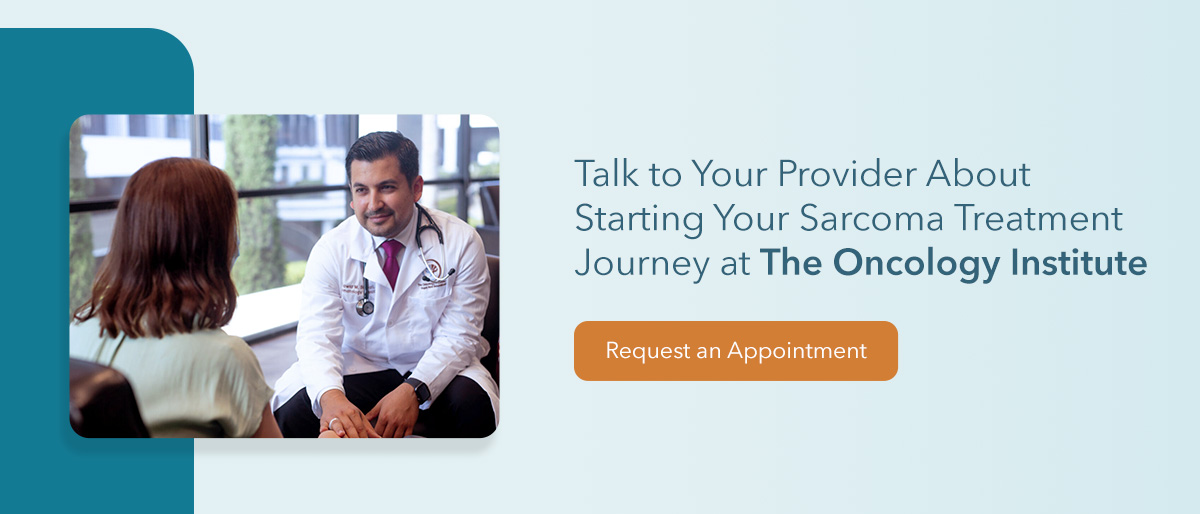

Advancements in treatment methods have significantly improved how providers treat sarcoma and related conditions. A cancer diagnosis and prognosis can feel overwhelming, but there is hope. Providers use various treatment methods such as chemotherapy, immunotherapy, radiation, and surgery to improve outcomes and increase survival rates. It's important to talk to your doctor about your options and start treatment early for the best results.
Sarcoma is a type of cancer that begins in supportive or connective tissue, such as:
There are more than 70 known subtypes of sarcoma, and they fall into the following categories:
Providers use various signs and symptoms to determine if you might have sarcoma. The most common signs are:
Symptoms are more common in the later stages of sarcoma than in the early stages. They differ based on the tumor's location and how advanced the diagnosis is, but you may notice the following:
Oncologists use the following tests to diagnose sarcoma and determine treatment options:
The anticipated outcome of your cancer and whether you respond well to treatment depend on your unique diagnosis. The likelihood of living with sarcoma for five or more years after diagnosis can range between 15% and 81%. The earlier it is detected and treated, the better outcomes you can typically expect.
Localized cancer, or cancer that hasn't spread throughout the body, generally has a higher long-term survival rate than metastatic cancer, or cancer that has spread. However, sarcoma treatment has advanced in recent years and significantly improved outcomes for many individuals. This is primarily due to the increase in more targeted therapies and personalized treatment approaches.
Oncology and pharmaceutical professionals also continue to study sarcoma, developing deeper understandings and new treatments to improve outcomes.
The right treatment for you depends on various factors such as the type of sarcoma you have, how far it has progressed, where it's located, and how fast it may spread to other parts of the body.
Pathologists use biopsy results to determine the grade of a tumor and how quickly its cells may grow. A health professional can work closely with you to determine the best options from these cancer treatment methods:
Surgery is not always necessary, but it is a primary sarcoma treatment. Providers often recommend surgery for a localized tumor that a surgeon can completely remove from the body.
Chemotherapy is a type of drug treatment that uses chemicals to destroy cancer cells and reduce their growth. If your provider decides chemotherapy is the best option, they will arrange for you to take oral medications or have intravenous (IV) injections. In some cases, you may have a combination of both.
Immunotherapy is another type of cancer drug treatment. It's a more targeted option that helps minimize damage to the surrounding healthy cells. Immunotherapy drugs help stimulate your body's immune system to fight cancer cells.
Your provider may combine chemotherapy and immunotherapy in your treatment plan or recommend immunotherapy in place of chemotherapy, depending on your diagnosis. Immunotherapy can increase the effectiveness of your cancer therapy while reducing the side effects of radiation and chemotherapy drugs.
Radiation therapy uses high-powered energy beams to shrink tumors and destroy cancer cells. If your provider recommends radiation treatment, they may use gamma rays, X-rays, or charged particles on a tumor. Oncologists often recommend radiation therapy to reduce a tumor's size before surgery or lower the risk of its return after surgery.
As researchers continue studying sarcoma, clinical trials may become available. The latest sarcoma studies focus on epigenetic treatments, which aim to reprogram cells and reverse patterns that cause cancer cell growth. While this type of treatment is not currently available, it may become an option in the future.
Your body's reaction to treatment can vary. Different side effects are possible with each treatment:
Nutrition can play a significant role in your health during cancer treatment, depending on where your cancer is and how you react to treatment. A tumor's location and certain treatment side effects may present challenges to your normal eating routine, but it's important to consume as many vitamins and nutrients as you can.
Small, frequent meals are often the best way to manage nutrition during treatment. Try to eat two to three foods every three to five hours to maintain energy. Stay hydrated, and try to eat plenty of carbohydrates and protein. You should talk to your health care provider for specific dietary guidance, but increasing the following protein-rich foods is often beneficial when undergoing cancer treatments:

A sarcoma diagnosis is easier to navigate with the right support. At The Oncology Institute, we believe in empowering and healing patients with state-of-the-art medical care and innovation. Our compassionate providers tailor treatment plans based on what will benefit you the most.
We provide unique services such as outpatient transfusions and a large clinical trials program, staying up to date on the most current treatment options. Learn more about our world-class cancer care, and talk to your primary care provider about receiving treatment at The Oncology Institute.